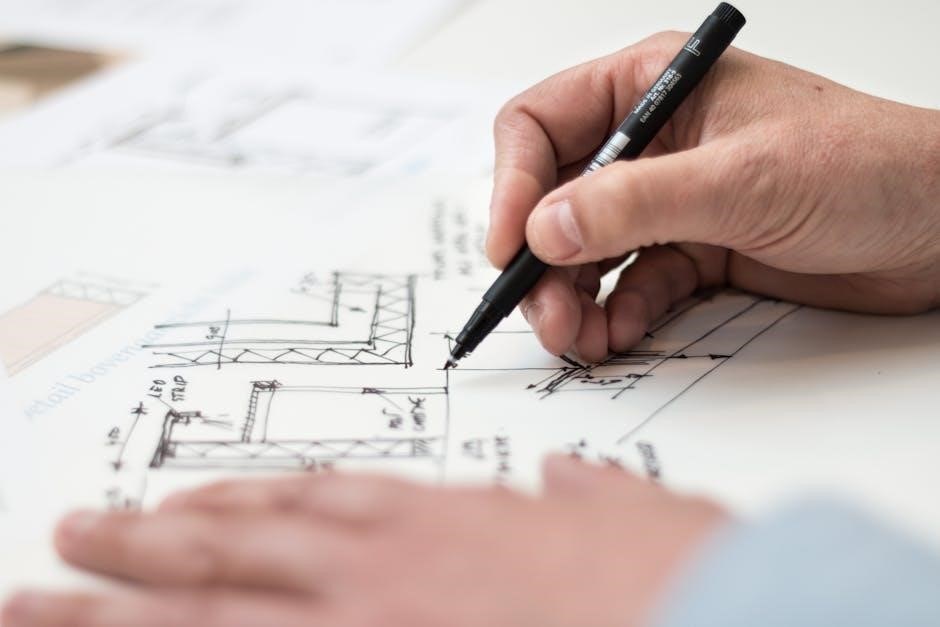The Millermatic 252 manual is a comprehensive guide for operating, maintaining, and troubleshooting the welding system․ It covers installation, safety precautions, and technical specifications, ensuring efficient and safe use of the equipment․ The manual is available for free download on Miller Electric’s official website, providing detailed instructions and diagrams for optimal performance․ It also includes warranty information and AI-powered maintenance tools for enhanced user support․
1․1 Overview of the Millermatic 252 Welding System
The Millermatic 252 is a versatile and powerful MIG/Flux-Cored welding system designed for professional-grade welding tasks․ It features a robust single-phase power source with 230V input, delivering consistent and high-quality welds on steel, stainless steel, and aluminum․ Known for its portability and ease of use, the system includes advanced controls for precise parameter adjustments․ Its durable construction and user-friendly interface make it ideal for both professionals and hobbyists, ensuring reliable performance across various welding applications․
1․2 Importance of the Manual for Safe and Effective Use
The Millermatic 252 manual is a critical resource for ensuring safe and effective operation of the welding system․ It provides detailed instructions for setup, operation, and maintenance, helping users avoid potential hazards․ The manual outlines essential safety protocols, such as proper grounding and ventilation, to prevent accidents․ Additionally, it offers troubleshooting guidance and technical specifications, enabling users to optimize performance and address issues efficiently․ Adhering to the manual’s guidelines is crucial for maximizing productivity while minimizing risks associated with welding operations․

Safety Precautions and Warnings
Adhering to safety guidelines is essential for preventing accidents and ensuring safe operation of the Millermatic 252․ Always follow proper equipment usage, ventilation, and emergency procedures․
2․1 Understanding Safety Symbols and Their Meanings
Safety symbols in the Millermatic 252 manual are critical for identifying risks and ensuring safe operation․ Common symbols include warning (triangles), caution (exclamation marks), and danger (skull icons)․ These markings highlight potential hazards like electrical shock, hot surfaces, or moving parts․ Always review and understand these symbols before operating the machine․ They are placed on the device and throughout the manual to alert users to specific risks․ Familiarizing yourself with these symbols is essential for preventing accidents and ensuring compliance with safety protocols․
2․2 General Safety Guidelines for Welding Operations
Adhering to safety guidelines is crucial for safe welding operations․ Always wear personal protective equipment (PPE), including a welding helmet, gloves, and safety glasses․ Ensure proper ventilation to avoid inhaling fumes․ Keep a fire extinguisher nearby and maintain a clean, clutter-free workspace․ Avoid loose clothing and jewelry that could catch fire or get entangled․ Use the correct welding techniques and follow the manufacturer’s instructions․ Regularly inspect equipment for damage․ Ground the machine properly to prevent electrical hazards․ Never weld near flammable materials or in confined spaces without proper precautions․ Stay alert and avoid fatigue during long welding sessions․
2․3 Hazards Associated with Installation, Operation, and Maintenance
The Millermatic 252 poses hazards during installation, operation, and maintenance if not handled properly․ Electrical hazards, such as shock or arcflash, can occur from improper grounding or voltage mismatch․ During operation, the welding arc generates extreme heat, risking burns or fires․ Inhaling welding fumes and particles can cause long-term health issues․ Maintenance tasks, like cleaning or replacing parts, may expose users to stored electrical energy or sharp edges․ Ensure all safety protocols are followed, and disconnect power before performing maintenance to minimize risks․ Proper training and precautions are essential to avoid accidents․
2․4 California Proposition 65 Warnings
The Millermatic 252 manual includes California Proposition 65 warnings to inform users about potential exposure to chemicals known to cause cancer, birth defects, or reproductive harm․ These warnings apply to certain components or emissions during welding operations․ Users are cautioned to avoid inhaling welding fumes or particles, as they may contain harmful substances․ Proper ventilation and protective equipment are essential to minimize exposure risks․ This notice is provided in compliance with California law to ensure user awareness and safety․ Adherence to safety guidelines is strongly recommended․

Installation Requirements
Proper installation of the Millermatic 252 requires a dedicated electrical circuit, adequate ventilation, and a clean workspace․ Adhere to manufacturer guidelines for safe setup and operation․
3․1 Electrical Service Recommendations
The Millermatic 252 requires a dedicated 208/240V electrical circuit with a minimum 40A breaker․ Ensure the circuit is properly grounded and meets local electrical codes․ Use a 6-gauge wire for installations over 50 feet to minimize voltage drop․ Avoid shared circuits with high-demand appliances to maintain stable power supply; Consult a licensed electrician for compliance with safety standards and optimal performance․ Proper grounding prevents electrical hazards, ensuring safe operation of the welding system․
3․2 Connecting to Weld Output Terminals
When connecting to the weld output terminals, ensure the power is off and wear protective gear․ Locate the positive and negative terminals, typically marked with polarity indicators․ Use high-quality welding cables of appropriate gauge to prevent overheating․ Secure connections tightly to avoid arcing or electrical issues․ Double-check polarity to match your welding setup․ Incorrect connections can damage the machine or pose safety risks․ Always refer to the manual for specific terminal configurations and follow proper safety protocols to ensure reliable operation․ Proper connections are vital for optimal performance and safety․
3․3 Threading Welding Wire
Threading welding wire on the Millermatic 252 requires precision to ensure smooth operation․ Begin by cutting the wire cleanly with wire cutters to avoid frayed ends․ Feed the wire through the gun’s liner, ensuring it moves freely without twists․ Guide the wire through the drive rolls and into the feeder․ Secure it firmly to prevent slippage․ Double-check for any twists or tangles, as these can cause feeding issues․ Properly seated wire ensures consistent weld quality and minimizes downtime․ Always use the correct wire type and size for your application․
3․4 Setting Up the Welding Gun
Setting up the welding gun on the Millermatic 252 involves several key steps to ensure optimal performance․ Begin by securely connecting the gun to the machine, ensuring a snug fit to maintain proper electrical contact․ Adjust the gun’s handle and angle for comfort and control, allowing precise manipulation during welding․ Inspect the gun’s liner for damage or blockages and clean or replace it as necessary․ Check the contact tip for wear and replace it if damaged to maintain consistent electrical flow․ Adjust the wire feed tension to prevent slippage or binding, following the manual’s guidelines for different wire types․ Finally, conduct a test run on scrap metal to verify smooth operation and make any necessary adjustments for consistent weld quality․

Operating the Millermatic 252
The Millermatic 252 operates efficiently with precise control over weld parameters․ Use the control panel to set voltage, wire feed speed, and other settings․ Always follow safety guidelines for optimal performance․
- Turn on the power and ensure all connections are secure․
- Adjust settings based on material type and thickness․
- Use the welding gun smoothly, maintaining consistent travel speed․
- Monitor the voltmeter and wire feed speed during operation․
4․1 Controls and Their Functions
The Millermatic 252 features an intuitive control panel designed for precise welding adjustments․ Key controls include the voltage control, wire feed speed knob, and run-in switch for smooth starts․
- The voltage control adjusts output voltage to suit different materials and thicknesses․
- The wire feed speed knob sets the wire feed rate for consistent weld quality․
- The run-in switch ensures a smooth arc start by gradually increasing wire feed speed․
- The jog trigger allows for no-load operation to test settings without welding․
- The voltmeter and wire feed speed meters provide real-time feedback during operation․
4․2 Adjusting Weld Parameters
Adjusting weld parameters on the Millermatic 252 ensures optimal weld quality for various materials and thicknesses․ Voltage and wire feed speed are primary settings that control penetration, bead profile, and weld consistency․ Use the control panel to fine-tune these parameters based on the material type and thickness․ Refer to the user manual for recommended settings for specific applications․ Adjustments may require trial and error to achieve desired results․ Always test settings on scrap material before welding the actual workpiece to ensure accuracy and avoid defects․
4․3 Using the Voltmeter and Wire Feed Speed Meter
The voltmeter and wire feed speed meter on the Millermatic 252 provide real-time monitoring of welding parameters․ The voltmeter measures the voltage output, ensuring consistent arc characteristics․ The wire feed speed meter tracks the wire feed rate, essential for maintaining proper penetration and weld bead formation․ Monitor these meters during operation to verify settings match your material and thickness requirements; Adjustments can be made using the control panel to fine-tune the weld output․ Proper use of these meters helps achieve precise control over the welding process, ensuring high-quality results․
4․4 Jog Mode and Run-In Settings
Jog Mode allows the Millermatic 252 to run the wire feed motor without welding, useful for purging the welding gun or creating test arcs․ Activating Jog Mode ensures proper wire positioning and eliminates waste․ Run-In settings control the initial wire feed speed and voltage when starting a weld, preventing birdsnesting․ Adjust these settings via the control panel for smooth starts․ Proper use of Jog Mode and Run-In settings enhances weld quality and reduces material waste, ensuring consistent results in various welding applications․

Troubleshooting Common Issues
Troubleshooting common issues with the Millermatic 252 involves identifying error codes, addressing wire feed problems, and resolving power-related faults․ Refer to the manual for detailed solutions and maintenance tips to ensure optimal performance and minimize downtime․ Regular checks and proper usage can prevent many issues, ensuring reliable welding operations․ Always consult Miller Electric support for unresolved problems․
5․1 Identifying and Resolving Overheating Problems
Overheating issues with the Millermatic 252 can occur due to blockages, excessive duty cycle, or poor ventilation․ Check for debris in the welding gun or torch, ensure proper airflow, and verify that the duty cycle matches the application․ Reduce weld time if overheating persists․ Clean the unit regularly and inspect cooling systems for damage․ Refer to the manual for temperature limits and maintenance tips․ If overheating recurs, consult Miller Electric support for further assistance or potential repairs․
5․2 Diagnosing Wire Feeding Issues
Wire feeding problems can stem from improper tension, blockages, or misaligned components․ Check the wire for tangles or kinks and ensure the gun is securely connected․ Verify drive roll settings match the wire type and size․ Clean the liner and conductor tube regularly to remove debris․ If issues persist, inspect the contact tips and rolls for wear․ Adjust tension or replace worn parts as needed․ Refer to the manual for specific troubleshooting steps and solutions to restore smooth wire feeding operation․
5․3 Addressing Power Output Problems
Power output issues may arise from unstable input voltage, overheating, or faulty components․ Check the input power source to ensure it meets specifications․ Verify circuit connections and reset the circuit breaker if necessary․ Inspect the duty cycle to prevent overload․ Clean or replace faulty contactors or relays․ If output remains inconsistent, consult the manual for recalibration steps or contact Miller support for assistance․ Always ensure proper ventilation to maintain optimal operating temperatures and performance․
5․4 Common Error Codes and Solutions
The Millermatic 252 may display error codes indicating specific issues․ For example, “E1” often relates to overheating, requiring the unit to cool down or checking ventilation․ “E2” may signify a wire feed problem, which can be resolved by cleaning the wire or adjusting tension․ “E3” could indicate a power supply issue, suggesting a check of input voltage or circuit stability․ Always refer to the manual for code definitions and follow recommended troubleshooting steps․ If unresolved, contact Miller Electric support for further assistance․

Maintenance and Upkeep
Proper maintenance ensures optimal performance and extends the lifespan of the Millermatic 252․ Regular cleaning, lubrication, and timely replacement of parts are essential for smooth operation․
6․1 Routine Cleaning and Lubrication
Regular cleaning and lubrication are crucial for maintaining the Millermatic 252’s performance․ Use a soft brush or cloth to remove dirt and spatter from the welder, gun, and wire feeder․ Lubricate moving parts, such as the wire feeder rollers and gearboxes, with a light machine grease․ Clean the cooling fan and vents to ensure proper airflow․ Check and replace worn or damaged seals․ Perform these tasks after every 40 hours of use or when visible contamination occurs to prevent wear and ensure smooth operation․
6․2 Replacing Parts and Consumables
Regularly inspect and replace worn or damaged parts to maintain the Millermatic 252’s efficiency․ Replace the contact tip, nozzle, and diffuser as needed to ensure consistent weld quality․ Check the wire liner and drive rolls for wear; replace them if damaged․ Use genuine Miller parts for optimal performance․ Turn off the power before performing any replacements․ Refer to the parts diagram for identification․ Keep spare consumables on hand to minimize downtime․ Replace parts every 500 hours of use or as indicated by visible wear․
6․3 Storing the Welding System Properly
Store the Millermatic 252 in a cool, dry location to prevent damage․ Clean the system thoroughly before storage to remove dirt and debris․ Cover the unit to protect it from dust․ Store the welding gun and consumables separately in a dry place․ Ensure all loose components are secured to avoid loss or damage․ Avoid exposing the system to direct sunlight or extreme temperatures․ Drain gas cylinders before storing them․ Proper storage extends the lifespan of your equipment and ensures optimal performance when reused․
6․4 Upgrading and Customizing the System
Upgrade your Millermatic 252 with optional features like advanced cooling systems or specialized welding torches for improved performance․ Customize settings using the digital interface for tailored welding experiences․ Consider adding a spool gun for aluminum welding or integrating automation tools for industrial settings․ Always use genuine Miller Electric parts to maintain warranty and performance․ Consult the manual or contact Miller support for guidance on upgrades․ Regularly update firmware for enhanced functionality; Customization allows you to optimize the system for specific welding tasks, ensuring efficiency and precision in your work․

Technical Specifications
The Millermatic 252 supports MIG and FCAW welding processes, operating on 230V input․ It features a 40% duty cycle at 250A, with wire compatibility up to 0․045 in;
7․1 Welding Processes Supported (MIG, FCAW)
The Millermatic 252 supports both MIG (GMAW) and FCAW (flux-cored arc welding) processes, offering versatility for various welding needs․ MIG welding is ideal for clean, precise welds on thin to medium-thickness materials, while FCAW provides excellent performance on thicker materials and in outdoor or dirty conditions․ The system is designed to handle both solid wire and flux-cored wire, making it suitable for a wide range of applications, from automotive repair to heavy-duty fabrication․ This dual capability ensures adaptability across different welding environments and projects․
7․2 Power Input and Output Requirements
The Millermatic 252 requires a 208-240V, single-phase input power supply for operation․ It delivers an output voltage of 30V under no-load conditions, ensuring safe operation․ The unit is designed to handle high-current welding applications, with a maximum rated output of 275A at 60Hz․ A 50A dedicated circuit is recommended for optimal performance․ The power input and output specifications are critical for ensuring stable welding performance and preventing electrical issues․ Proper power setup guarantees reliable operation across various welding tasks and materials․
7․3 Duty Cycle and Rated Output
The Millermatic 252 has a duty cycle of 40% at 275A, allowing continuous operation without overheating․ Its rated output is 150A at 240V, ensuring consistent performance for demanding welding tasks․ The duty cycle is crucial for maintaining equipment longevity and preventing thermal overload․ The welder’s cooling system efficiently manages heat during extended use, while the rated output ensures stable arc performance․ Adhering to these specifications guarantees optimal welding results and prevents premature wear on internal components․ Always refer to these ratings for safe and efficient operation․
7․4 Wire Compatibility and Feeding Speed
The Millermatic 252 supports a wide range of welding wires, including solid, flux-cored, and metal-cored wires․ It accommodates wire diameters from 0․023 to 0․045 inches, ensuring versatility for different welding applications․ The wire feed speed is adjustable, with a maximum of 700 inches per minute (IPM), allowing precise control over wire delivery․ Proper wire selection and feeding speed adjustment are critical for achieving consistent weld quality․ Always refer to the manual for specific wire recommendations and feeding guidelines to optimize performance for your welding projects․

Accessories and Compatibility
The Millermatic 252 is compatible with various welding guns, feeders, and shielding gases․ Accessories include cooling systems, wire feeders, and protective equipment like helmets and gloves․
8․1 Compatible Welding Guns and Feeders
The Millermatic 252 works seamlessly with Bernard and Tweco welding guns, ensuring precise control and consistent performance․ The system is also compatible with various wire feeders, including the AccuLock and Euro Connect systems, which simplify wire management․ These accessories are designed to optimize wire feeding accuracy and reduce downtime․ Always ensure compatibility by consulting the manual or contacting Miller Electric directly for the latest updates and recommendations to maintain optimal performance and safety․
8․2 Shielding Gas Requirements
The Millermatic 252 requires specific shielding gases to ensure high-quality welds․ For MIG welding, 75% argon/25% CO2 or 100% CO2 is recommended for steel, while 100% argon is ideal for aluminum․ Flow rates should be adjusted between 20-30 CFH, depending on weld thickness and joint design․ Using the correct gas type and purity is crucial to prevent porosity and ensure proper shielding․ Always use high-quality gas cylinders and regulators compatible with the system to maintain consistent weld performance and safety․ Consult the manual for specific gas recommendations based on your welding application․
8․3 Cooling Systems and Optional Gear
The Millermatic 252 features an advanced cooling system designed to manage thermal output efficiently, ensuring consistent performance during extended welding sessions․ Proper cooling is essential for maintaining the system’s longevity and preventing overheating․ Optional cooling upgrades, such as enhanced fans or external cooling units, can be installed for high-duty-cycle applications․ Additionally, optional accessories like welding carts, remote controls, and spool guns can enhance versatility and productivity, allowing users to customize the system to meet specific welding needs and workplace requirements․
8․4 Additional Tools and Equipment
To maximize the performance of the Millermatic 252, consider adding tools like welding carts for portability, high-quality welding helmets with auto-darkening lenses, and wire brushes for surface preparation․ Optional equipment such as magnetic clamps, shielding gas lenses, and TIG torches can expand the system’s versatility․ These accessories enhance precision, safety, and efficiency, ensuring optimal results in various welding applications․ Always choose tools compatible with the Millermatic 252 to maintain performance and reliability․

Warranty and Customer Support
The Millermatic 252 is backed by a comprehensive warranty and dedicated customer support, ensuring assistance with repairs, troubleshooting, and technical inquiries for optimal user experience․
9․1 Understanding the Warranty Terms
The Millermatic 252 warranty provides coverage for defects in materials and workmanship․ The standard warranty period is three years for the power source, one year for the feeder, and six months for the gun․ Coverage includes repair or replacement of defective parts at no cost․ Registration is recommended to validate the warranty․ Exclusions apply for misuse, improper maintenance, or unauthorized modifications․ Refer to the manual for detailed terms and conditions to ensure compliance and maximize warranty benefits․
9․2 Contacting Miller Electric Customer Service
For assistance with the Millermatic 252, contact Miller Electric customer service via phone, email, or their official website; Phone support is available Monday through Friday during business hours․ Use the contact form on their website for inquiries or troubleshooting․ Representatives are trained to address technical questions, repair requests, or general support needs․ Ensure to have your unit’s serial number ready for faster service․ Visit their official website for contact details and additional resources to resolve your concerns efficiently․
9․3 Online Resources and Community Support
Miller Electric offers extensive online resources for the Millermatic 252, including user manuals, troubleshooting guides, and repair tips․ Visit their official website to access a comprehensive FAQ section and instructional videos․ Additionally, join online forums and social media groups dedicated to Miller Electric products for peer-to-peer support․ These platforms are ideal for sharing experiences, resolving issues, and learning new techniques․ For real-time assistance, utilize the live chat feature on their website or explore the Miller Electric mobile app for convenient support access․

User Resources and Documentation
The Millermatic 252 manual offers comprehensive user resources, including PDF guides, parts diagrams, and video tutorials, all accessible through the official Miller Electric website for easy reference․
10․1 Downloading the Manual
To access the Millermatic 252 manual, visit the official Miller Electric website․ Navigate to the “Support” section and enter “Millermatic 252” in the search bar․ Select the correct model to download the PDF manual․ Ensure you have Adobe Acrobat Reader installed for viewing․ The manual is available in multiple languages and includes detailed instructions for installation, operation, and troubleshooting․ Regularly check for updates to ensure you have the latest version with improved guidelines and technical specifications․
10․2 Accessing Parts Lists and Diagrams
To access parts lists and diagrams for the Millermatic 252, visit the Miller Electric official website․ Navigate to the “Support” or “Parts” section and search for “Millermatic 252․” Downloadable PDF documents are available, detailing exploded views of components, part numbers, and assembly instructions․ These resources are essential for maintenance, repairs, and ordering replacement parts․ Ensure to refer to the official Miller Electric diagrams for accuracy when performing repairs or upgrades to maintain safety and performance․
10․3 AI-Powered Maintenance Tools
The Millermatic 252 manual introduces AI-powered maintenance tools designed to optimize upkeep and extend equipment life․ These tools utilize predictive analytics to monitor usage patterns and detect potential issues before they escalate․ Users can access maintenance schedules, error diagnostics, and personalized recommendations through the Miller Electric app or online portal․ The AI system also tracks wire usage and suggests replacement intervals, ensuring seamless operation․ Regular use of these tools helps prevent unexpected downtime and ensures the welding system operates at peak performance levels consistently․
The Millermatic 252 manual provides comprehensive guidance for safe, effective, and efficient welding․ Adhering to its instructions ensures optimal performance and longevity of the equipment․
11․1 Final Tips for Optimal Use
For the best experience with your Millermatic 252, always ensure proper setup and maintenance․ Regularly inspect and clean the welding gun, and check wire tension for consistent feeding․ Use the correct shielding gas for your application to achieve high-quality welds․ Monitor and adjust weld parameters to suit the material thickness and type․ Keep the duty cycle in mind to avoid overheating․ Finally, store the system in a dry, cool place when not in use to maintain its performance and longevity․ Proper care ensures reliable operation and lasting durability․
11․2 Encouragement to Follow Safety Guidelines
Always prioritize safety when using the Millermatic 252 to protect yourself and others․ Wear proper PPE, including a welding helmet, gloves, and safety glasses, to prevent injuries․ Ensure good ventilation to avoid inhaling fumes and particles․ Regularly inspect equipment for damage or wear and address issues promptly․ Follow all safety symbols and guidelines outlined in the manual to minimize risks․ By adhering to safety practices, you ensure a safe and efficient welding experience while maintaining the longevity of your equipment․




Leave a Reply
You must be logged in to post a comment.